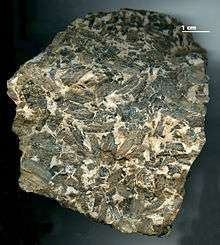Fusain

Fusain is a fossilised carbon deposit which, after some controversy, has been identified as fossilised charcoal.[1] It is fibrous, black and opaque, and often preserves details of cell wall architecture. Wood-derived fusain usually takes the form of cubic blocks, whereas fusain from other plant material may take the form of thin films which are only visible under a microscope where the surrounding rock is dissolved by acid maceration.[1] The material is silky and crumbles on the touch.[1] The loss of volatile elements during combustion means that fusain fossils are usually smaller than the original organism, but this same factor makes them unlikely to be eaten by any animals (for they have no nutritional value), enhancing their preservation potential.[1]
Fusain shows characteristics diagnostic of pyrolysis in modern material: the cell walls of xylem are homogenized, and subsequently crack along their middles.[2]
Further reading
- Taylor, Thomas N; Taylor, Edith L; Krings, Michael (2009). Paleobotany: The biology and evolution of fossil plants. ISBN 978-0-12-373972-8.
References
- 1 2 3 4 Scott A (2000). "The Pre-Quaternary history of fire". Palaeogeogr Palaeoclimatol Palaeoecol. 164 (1–4): 281–329. doi:10.1016/S0031-0182(00)00192-9.
- ↑ Jones, T.; Chaloner, W. (1991). "Fossil charcoal, its recognition and palaeoatmospheric significance". Palaeogeography, Palaeoclimatology, Palaeoecology. 97: 39–50. doi:10.1016/0031-0182(91)90180-Y.
http://www.palaeocast.com/episode-22-fire-and-charcoal/#.U446-i-KWKO